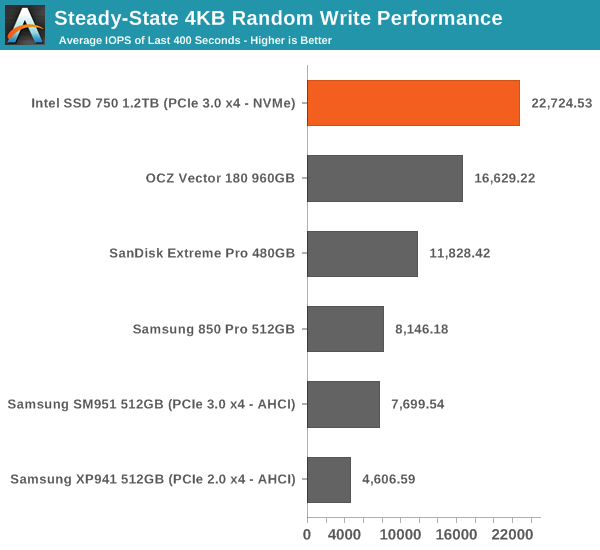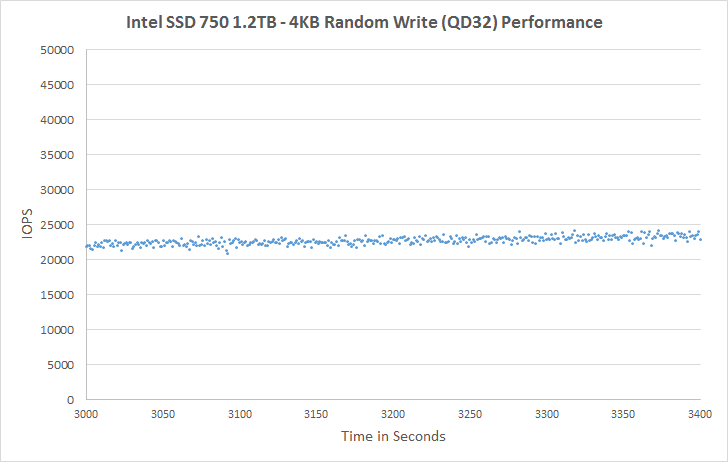Intel SSD 750 PCIe SSD Review: NVMe for the Client
by Kristian Vättö on April 2, 2015 12:00 PM ESTPerformance Consistency
We've been looking at performance consistency since the Intel SSD DC S3700 review in late 2012 and it has become one of the cornerstones of our SSD reviews. Back in the days many SSD vendors were only focusing on high peak performance, which unfortunately came at the cost of sustained performance. In other words, the drives would push high IOPS in certain synthetic scenarios to provide nice marketing numbers, but as soon as you pushed the drive for more than a few minutes you could easily run into hiccups caused by poor performance consistency.
Once we started exploring IO consistency, nearly all SSD manufacturers made a move to improve consistency and for the 2015 suite, I haven't made any significant changes to the methodology we use to test IO consistency. The biggest change is the move from VDBench to Iometer 1.1.0 as the benchmarking software and I've also extended the test from 2000 seconds to a full hour to ensure that all drives hit steady-state during the test.
For better readability, I now provide bar graphs with the first one being an average IOPS of the last 400 seconds and the second graph displaying the standard deviation during the same period. Average IOPS provides a quick look into overall performance, but it can easily hide bad consistency, so looking at standard deviation is necessary for a complete look into consistency.
I'm still providing the same scatter graphs too, of course. However, I decided to dump the logarithmic graphs and go linear-only since logarithmic graphs aren't as accurate and can be hard to interpret for those who aren't familiar with them. I provide two graphs: one that includes the whole duration of the test and another that focuses on the last 400 seconds of the test to get a better scope into steady-state performance.

Given the higher over-provisioning and an enterprise-oriented controller, it's no surprise that the SSD 750 has excellent steady-state random write performance.

The consistency is also very good, although the SSD 750 can't beat the 850 Pro if just focusing on consistency. When considering that the SSD 750 provides nearly three times the performance, it's clear that the SSD 750 is better out of the two.
 |
|||||||||
| Default | |||||||||
At the initial cliff the performance drops to around 15K IOPS, but it quickly rises and seems to even out at about 22-23K IOPS. It actually takes nearly an hour for the SSD 750 to reach steady-state, which isn't uncommon for such a large drive but it's still notable.
I couldn't run tests with added over-provisioning because NVMe drives don't support the usual ATA commands that I use to limit the LBA of the drive. There is similar command set for NVMe as well, but I'm still trying to figure out how to use them as there's isn't too much public info about NVMe tools.
 |
|||||||||
| Default | |||||||||










132 Comments
View All Comments
magreen - Thursday, April 2, 2015 - link
darkgreen, are you talking about a G1 without TRIM or a G2 with TRIM support?darkgreen - Friday, April 3, 2015 - link
I had a G1 without TRIM. The Intel fix was based on some ancient shareware (FreeDOS!) that wouldn't work with many modern motherboards and in some cases left drives bricked. It was well reported at the time (see my comment above for a google search that returns articles), but lots of people wound up with X25-Ms that were useless. If you weren't an enterprise customer the Intel response was "tough luck." No refunds, no replacements, nothing. In all fairness I'm sure Intel would love to be able to support consumers, but they probably aren't set up for it in their storage area because it's just not a big area of their business bottom line.magreen - Sunday, April 5, 2015 - link
Yeah, it seems like the G1 owners got screwed. (I have a G2 and G3 and they've both been great. Sorry they screwed the early adopters.)In Anand's words from 2009 when the G2 was released:
"TRIM isn’t yet supported, but the 34nm drives will get a firmware update when Windows 7 launches enabling TRIM. XP and Vista users will get a performance enhancing utility (read: manual TRIM utility). It seems that 50nm users are SOL with regards to TRIM support. Bad form Intel, very bad form."
http://anandtech.com/show/2806
"Overall the G2 is the better drive but it's support for TRIM that will ultimately ensure that. The G1 will degrade in performance over time, the G2 will only lose performance as you fill it with real data. I wonder what else Intel has decided to add to the new firmware...
I hate to say it but this is another example of Intel only delivering what it needs to in order to succeed. There's nothing that keeps the G1 from also having TRIM other than Intel being unwilling to invest the development time to make it happen. I'd be willing to assume that Intel already has TRIM working on the G1 internally and it simply chose not to validate the firmware for public release (an admittedly long process). But from Intel's perspective, why bother?
Even the G1, in its used state, is faster than the fastest Indilinx drive. In 4KB random writes the G1 is even faster than an SLC Indilinx drive. Intel doesn't need to touch the G1, the only thing faster than it is the G2. Still, I do wish that Intel would be generous to its loyal customers that shelled out $600 for the first X25-M. It just seems like the right thing to do. Sigh."
http://www.anandtech.com/show/2829/11
Redstorm - Thursday, April 2, 2015 - link
Could you elaborate on this (although there appears to be an NVMe version too after all) of the SM951. As looking at the numbers if NVMe even slightly improves the SM951 it would make it a better choice, and the form factor being M.2 makes it much more attractive.Kristian Vättö - Thursday, April 2, 2015 - link
Ganesh received an NVMe version of the SM951 inside a NUC and I've also heard from other sources that it exists. No idea of its retail availability, though, as RamCity hadn't heard about it until I told them.eddieobscurant - Thursday, April 2, 2015 - link
if i'm not wrong the nvme version has p/n MZVPV256HDGL-00000 for the 256gb model while the ahci version has p/n MZHPV256HDGL-00000Redstorm - Friday, April 3, 2015 - link
Thanks looks promising , found this with verbage suposidly from RAMCity that they will ship in May.http://translate.google.co.nz/translate?hl=en&...
Redstorm - Friday, April 3, 2015 - link
So no real proof that they exist then.eddieobscurant - Thursday, April 2, 2015 - link
Kristian, there is a DRAM difference between the two models. The 400gb has 1gb DRAM while the 1.2tb model has 2gb. Do you think it plays a big role in terms of performance between the two models.Also is there a way to reduce the overprovision in these drives? I would prefer 80gb more on the 400gb model over less consistency.
When will you review the kingston hyperX predator, and when will samsung release the sm951 nvme? Q3 or sooner?
KAlmquist - Thursday, April 2, 2015 - link
The 400gb model shouldn't need as much DRAM because it has fewer pages to keep track of. But there's no way to know how the 400gb model will perform until Intel sends out samples for review.